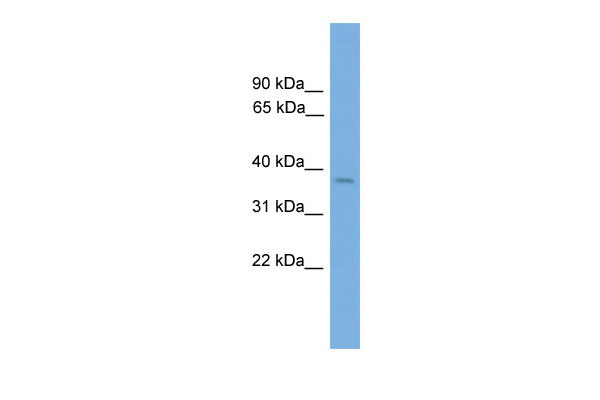Six3 antibody - C-terminal region
Rabbit Polyclonal Antibody
- 产品详情
- 实验流程
Application
| WB |
|---|---|
| Primary Accession | Q62233 |
| Other Accession | NM_011381, NP_035511 |
| Reactivity | Human, Mouse, Rat, Zebrafish, Bovine |
| Predicted | Mouse, Zebrafish |
| Host | Rabbit |
| Clonality | Polyclonal |
| Calculated MW | 35593 Da |
| Gene ID | 20473 |
|---|---|
| Alias Symbol | Six3a, Six3alpha, Six3b, Six3beta, E130112M24Rik |
| Other Names | Homeobox protein SIX3, Sine oculis homeobox homolog 3, Six3 |
| Format | Liquid. Purified antibody supplied in 1x PBS buffer with 0.09% (w/v) sodium azide and 2% sucrose. |
| Reconstitution & Storage | Add 50 ul of distilled water. Final anti-Six3 antibody concentration is 1 mg/ml in PBS buffer with 2% sucrose. For longer periods of storage, store at 20°C. Avoid repeat freeze-thaw cycles. |
| Precautions | Six3 antibody - C-terminal region is for research use only and not for use in diagnostic or therapeutic procedures. |
| Name | Six3 |
|---|---|
| Function | Transcriptional regulator which can act as both a transcriptional repressor and activator by binding a ATTA homeodomain core recognition sequence on these target genes. During forebrain development represses WNT1 expression allowing zona limitans intrathalamica formation and thereby ensuring proper anterio-posterior patterning of the diencephalon and formation of the rostral diencephalon (PubMed:18094027). Acts as a direct upstream activator of SHH expression in the rostral diencephalon ventral midline and that in turn SHH maintains its expression (PubMed:18775421). In addition, Six3 activity is required for the formation of the telencephalon. During postnatal stages of brain development is necessary for ependymal cell maturation by promoting the maturation of radial glia into ependymal cells through regulation of neuroblast proliferation and migration (PubMed:22071110). Acts on the proliferation and differentiation of neural progenitor cells through activating transcription of CCND1 AND CCND2 (PubMed:17576749). During early lens formation plays a role in lens induction and specification by activating directly PAX6 in the presumptive lens ectoderm (PubMed:17066077). In turn PAX6 activates SIX3 resulting in activation of PDGFRA and CCND1 promoting cell proliferation (PubMed:12072567). Also is required for the neuroretina development by directly suppressing WNT8B expression in the anterior neural plate territory (PubMed:20890044). Its action during retina development and lens morphogenesis is TLE5 and TLE4-dependent manner. Furthermore, during eye development regulates several genes expression. Before and during early lens development represses the CRYGF promoter by binding a SIX repressor element (PubMed:11139622). Directly activates RHO transcription, or cooperates with CRX or NRL (PubMed:17666527). Six3 also functions in the formation of the proximodistal axis of the optic cup (PubMed:12163408), and promotes the formation of optic vesicles-like structures (PubMed:11458394). During pituitary development, acts in parallel or alternatively with HESX1 to control cell proliferation through Wnt/beta-catenin pathway (PubMed:18694563). Plays a role in eye development by suppressing WNT1 expression and in dorsal-ventral patterning by repressing BMP signaling pathway (By similarity). |
| Cellular Location | Nucleus {ECO:0000255|PROSITE-ProRule:PRU00108, ECO:0000269|PubMed:12050133} |
| Tissue Location | Expressed in ependymal cells during the formation of the lateral wall. |
Research Areas
For Research Use Only. Not For Use In Diagnostic Procedures.
Application Protocols
Provided below are standard protocols that you may find useful for product applications.
终于等到您。ABCEPTA(百远生物)抗体产品。
点击下方“我要评价 ”按钮提交您的反馈信息,您的反馈和评价是我们最宝贵的财富之一,
我们将在1-3个工作日内处理您的反馈信息。
如有疑问,联系:0512-88856768 tech-china@abcepta.com.























 癌症的基本特征包括细胞增殖、血管生成、迁移、凋亡逃避机制和细胞永生等。找到癌症发生过程中这些通路的关键标记物和对应的抗体用于检测至关重要。
癌症的基本特征包括细胞增殖、血管生成、迁移、凋亡逃避机制和细胞永生等。找到癌症发生过程中这些通路的关键标记物和对应的抗体用于检测至关重要。 为您推荐一个泛素化位点预测神器——泛素化分析工具,可以为您的蛋白的泛素化位点作出预测和评分。
为您推荐一个泛素化位点预测神器——泛素化分析工具,可以为您的蛋白的泛素化位点作出预测和评分。 细胞自噬受体图形绘图工具为你的蛋白的细胞受体结合位点作出预测和评分,识别结合到自噬通路中的蛋白是非常重要的,便于让我们理解自噬在正常生理、病理过程中的作用,如发育、细胞分化、神经退化性疾病、压力条件下、感染和癌症。
细胞自噬受体图形绘图工具为你的蛋白的细胞受体结合位点作出预测和评分,识别结合到自噬通路中的蛋白是非常重要的,便于让我们理解自噬在正常生理、病理过程中的作用,如发育、细胞分化、神经退化性疾病、压力条件下、感染和癌症。






